CBSE Class 12 Physics MCQs Solution All Chapters
Free PDF Download of CBSE Physics Multiple Choice Questions for Class 12 with Answers Chapter 1 Electric Charges and Fields. Physics MCQs for Class 12 Chapter Wise with Answers PDF Download was Prepared Based on Latest Exam Pattern. Students can solve NCERT Class 12 Physics Electric Charges and Fields MCQs Pdf with Answers to know their preparation level.
Electric Charges and Fields MCQ
1 . If a body is charged by rubbing it, its weight
- Always decreases slightly
- Always increases slightly
- May increase slightly or may decrease slightly
- Remains precisely the same
Answer/Explanation
1 . (3)
If a body is charged by rubbing it, then it may lose or gain electrons. Since electrons have a mass of (9.1 x 10-31kg). So, a slight weight may increase or decrease slightly.
2. Safety fuse should have
- High resistance and high MP
- High resistance and low MP
- Low resistance and high MP
- Low resistance and low MP
Answer/Explanation
2. (2)
The safety bulb should have high resistance and low melting point.
3. 3 charges +4q, Q and q are placed in a straight line of length l at points distance 0, 0.5 and 1 respectively. What should be the value of Q in order to make the net force on q to be zero?
- -q
- -2q
- -q/2
- 4q
Answer/Explanation
3. (1)
Two forces are acting on q one due to 4q and second due to Q

F1 + F2 = 0

Q = -q
4. In the winter season, a mild spark is often seen when a man touches somebody’s else’s skin. Why?
- Due to lack of humidity and rubbing with clothes, charge accumulate on human body which is discharged via sparking
- Due to cold, electrostatic charge on body finds a lower resistance path to the skin of other’s body
- He static charge on sweaters worn by the two persons is different, hence discharge through sparking occurs
- Similar to the lighting, extremely high potential exists on both the bodies and hence they discharge through sparking
Answer/Explanation
4. (1)
Due to friction between skin and cloths, electrostatic charge is built up on the skin. Hence, electrical discharge may occur when a man touches somebody else. This phenomenon is more significant in winters because due to low humidity, charge has a tendency to stay longer on the body.
5. There are two charges +2microC and -3microC. The ratio of forces acting on them will be
- 2 : 3
- 1 : 1
- 3 : 2
- 4 : 9
Answer/Explanation
5. (2)


6. When a comb is rubbed with hair, it attracts paper bits. Choose the right explanation.
- Bits of paper gets attracted due to gravitational force
- Due to electromagnetic effect, bits of paper are attracted
- Comb gets charged by friction and attract bits of paper
- None of these
Answer/Explanation
6. (3)
When a comb is rubbed with the hair, it induces negative charge due to friction. When it is brought closer to paper bits, they get polarized and the positive part stacks to the comb due to electrostatic attraction.
7. Four charges +Q, -Q, +Q and -Q are situated at the corners of a square; in a sequence then at the centre of the square
- E = 0, V = 0
- E = 0, V ≠ 0
- E ≠ 0, V = 0
- E ≠ 0, V ≠ 0
Answer/Explanation
7. (1)
8. A spherical conducting ball is suspended by a grounded conducting thread. A positive point charge is moved near the ball. That ball will
- Be attracted to the point charge and swing toward it
- Be repelled from the point charge and swing away from it
- Not be affected by the point charge
- None of these
Answer/Explanation
8. (1)
Due to the positive charge present, negative charge will be induced. Hence, attraction will take place.
9. Electric force can be
- Always attractive
- Always repulsive
- Attractive and repulsive
- None of these
Answer/Explanation
9. (3)
Electric forces can be both attractive and repulsive. Same charges repel each other while unlike nature of charge attract each other.
10. A charge Q is divided into two parts of q and Q-q. If the coulomb repulsion between them when they are separated , is to be maximum, the ratio of Q/q is
- 2
- ½
- 4
- ¼
Answer/Explanation
10. (1)
Let the charges be separated by a distance ‘d’

Maximum force will be got after differentiating the force equation

For maximum or minimum force


Q – 2q = 0
Q = 2q
Q/q = 2
11. Two neutrons are placed at some distance apart from each other. They will
- Attract each other
- Repel each other
- Neither repel nor attract each other
- Depends on the distance between the two nucleus
Answer/Explanation
11. (4)
If the intermolecular distance is less than 0.8pm, then the nucleus will repel each other and if the intermolecular distance is more than 0.8 pm, the nucleus will attract each other.
12. Two bodies X and Y carry charges -6.6µC and -5µC. How many electrons should be transferred from X to Y so that they acquire equal charges?
- 2 x 1012
- 5 x 1014
- 5 x 1012
- 5 x 1013
Answer/Explanation
12. (3)
X has excess charge of -1.6 x 10-6 C composed to Y
X has to give a charge -0.8 x 10-6 C if charge on both have to be the same
The charge on one electron is -1.6 x 10-19 C
The number of electrons required to transfer a charge of -0.8 x 10-6 C =

13. An electric charge is held at rest in a region filled with a non-uniform magnetic field. As soon as it is left free
- It will move in the direction of the field
- It will move opposite to the direction of the field
- It will move perpendicular to the direction of the field
- It will remain at rest
Answer/Explanation
13. (3)
As soon as it is left free it will move perpendicular to the direction of the electric field.
14. Which one of the following is a bad conductor?
- Acid
- Coal
- Distilled water
- Human body
Answer/Explanation
14. (3)
Distilled water is an insulator.
15. SI unit of electric flux is
- Voltmeter
- Joule/metre
- Newton
- None
Answer/Explanation
15. (2)
E = V = dE
E = dv/dx = V/m
16. A charge is placed at the edge of a cube of side length ‘a’. Calculate the electric flux through each other face of the cube.
- Q / 4𝛜o
- Q / 24𝛜o
- Q / 2𝛜o
- Q / 15𝛜o
Answer/Explanation
16. (2)
Flux through each cube will be Q / 4𝛜o . The flux through each face will be Q / 24𝛜o .
17. Electric flux per unit solid angle is defined as
- Electric force
- Electric field intensity
- Electric potential
- Electric power
Answer/Explanation
17. (2)
F1 = qE; F2 = -qE; Fnet = F1 + F2 = 0
18. An electric dipole is placed in a uniform electric field. The net electric force on the dipole.
- Is always zero
- Depends on the orientation
- Depends on the dipole moment
- Is always finite but not zero
Answer/Explanation
18. (1)
Is always zero
19. Induction is possible
- Only in conductor
- Only in insulator
- Both in conductor and insulator
- None of these
Answer/Explanation
19. (1)
Only conductor can be inducted as the process involves movement and electrons. Only conductors have free electrons in there which help in the conduction process to take place.
20. When the separation between two charges is increased the electric potential energy of the charges
- increases
- decreases
- remains the same
- may increase or decrease
Answer/Explanation
20. (2)
The potential energy in inversely proportional to square of distance between the charges. The potential energy also depends directly proportional to the nature (sign) of the charges. If the nature of both the charges is same, then the potential will decrease, if the nature of the both the charges are different, then the potential increase.
21. If a positive charge is shifted from a low potential region to high potential region, the electric potential energy
- decreases
- remains the same
- may increase or decrease
- increases
Answer/Explanation
21. (4)
PE = qV
Since positive charge is shifted from low and high potential.
if q = +ve and V = +ve, PE increases.
22. Mark out the correct options.
- Total positive charge of the universe is constant
- Total negative charge of the universe is constant
- Total number of charged particles in the universe is constant
- The total charge of the universe is constant
Answer/Explanation
22. (4)
According to the principal of conservation of charge, the total amount of positive charge minus the total amount of negative charge in the universe is constant. Therefore, the total charge of the universe in constant.
23. A Proton and an electron are placed in a uniform electric field
- the electric forces acting on them will be equal
- the magnitudes of the forces will be equal
- their acceleration will be equal
- the magnitude of their acceleration will be equal
Answer/Explanation
23. (2)
The proton and electrons have equal and opposite charges. Therefore, the magnitude of the force i equal hen kept in an electric field.
24. An electric dipole is placed in an electric field generated by a point charge.
- The net electric force on the dipole must be zero
- The net electric force on the dipole maybe zero
- The torque on the dipole due to field must be zero
- The torque on the dipole due to the field may be zero
Answer/Explanation
24. (4)
If the dipole moment and the electric field are parallel to each other, then the torque will be zero as pEsin0 = 0
25. Electric lines of force
- exist everywhere
- exist only in the immediate vicinity of electric charges
- exist only when both positive and negative charges and near one and other
- are imaginary
Answer/Explanation
25. (4)
Electric lines of force are imaginery.
26. Which of the following statements is not true about Gauss’s law
- Gauss’s law is not much useful in calculating electrostatic field when the system has some symmetry
- Gauss’s law is based on the Inverse Square dependence on distance contained in the Coulomb’s law
- Gauss’s law is true for any closed surface
- The term Q on the right side of gases law includes the sum of all charges in closed by the surface
Answer/Explanation
26. (1)
Gauss’s law is useful for an easier calculations of electrostatic field when the system has some symmetry. This can be done with the correct choice of Gaussian surface.
27. Two infinite plate parallel sheets separated by a distance D have equal and opposite uniform charge densities σ. Electric field at a point between the sheets is
- σ/2𝛜o
- σ/𝛜o
- Zero
- Depends on the location of the point
Answer/Explanation
27. (2)
σ/𝛜o
28. The electric field at a point on axial line of a dipole and direction of the dipole moment
- Will be parallel and in the same direction
- Will be in opposite direction
- Will be perpendicular
- Are not related
Answer/Explanation
28. (3)
29. If an electron has an initial velocity in a direction different from that of an electric field, the path of the electron is:
- a straight line
- a circle
- an ellipse
- a parabola
Answer/Explanation
29. (4)
The path will be a parabola, as the velocity will be resolved into two components, one parallel to electric field and one perpendicular to the electric field.
30. Electric lines of force about a negative point charge are
- circular anticlockwise
- circular clockwise
- radial, inwards
- radial, outwards
Answer/Explanation
30. (3)
The electric lines of force are radial and inwards.
31. If Ea be the electric field strength of a short dipole at a point on its axial line and Ee that on the equatorial line at the same distance, then
- Ee=2Ea
- Ee=Ea
- Ea=2Ee
- Ee=4Ea
Answer/Explanation
31. (1)
Ea = 2Ee
32. The surface considered for Gauss’s law is called
- Closed surface
- Spherical surface
- Gaussian surface
- Plane surface
Answer/Explanation
32. (3)
The surface considered for Gauss’s law is called Gaussian surface.
33. A hemisphere is uniformly charged positively. The electric field at a point on a diameter away from the centre is directed:
- perpendicular to the diameter
- parallel to the diameter
- at an angle tilted towards the diameter
- at an angle tilted away from the diameter
Answer/Explanation
33. (1)
When the point is on the diameter and away from the centre of hemisphere which is charged uniformly and +vely, the component of electric field intensity parallel to the diameter cancel out.
34. The electric field at a point 5 cm from a long line charge of density 2.5 x 10-6 cm-1 is
- 9 x 103 NC-1
- 9 x 104 NC-1
- 9 x 104 NC-1
- 9 x 104 NC-1
Answer/Explanation
34. (3)
E = 2λ/4π𝛜or = (9 x 109 x 2 x 2.5 x 10-6) / 5 x 10-2 = 9 x 105 NC-1
35. The field at a distance r from a long straight wire of charge per unit length ƛ is
- kƛ / r2
- kƛ / r
- kƛ / 2r
- 2kƛ / r
Answer/Explanation
35. (4)
2kƛ / r
36. F is the force between two charges. If the distance between them is tripled, then the force between the charges will be
- F
- F / 3
- F / 9
- F / 27
Answer/Explanation
36. (3)
F/9
37. An attractive force of 9N acts between +5C and -5C at some distance. These charges are allowed to touch each other and are then again placed at their initial position. The force acting between them will be
- infinite
- 9 x 109 N
- 1 N
- zero
Answer/Explanation
37. (4)
38. SI unit of volume charge density is
- cm-1
- cm-2
- cm-3
- cm-4
Answer/Explanation
38. (3)
cm-3
39. The resultant electric field at centre of a ring due to ring is zero. Which of the following is incorrect
- The total charge of the ring may be zero, although everywhere
- The charge on the ring must be uniformly distributed
- The charge on the ring may be distributed non-uniformly
- Total charge on the ring may be positive
Answer/Explanation
39. (3)
The charge on the ring must be uniformly distributed
40. If two charged particles of same mass and charge are projected in a uniform electric field with the same speed, then
- Both have same momentum at any instant
- Both have same kinetic energy at any instant
- Both have same magnitude of momentum at any instant
- They may move on a straight line
Answer/Explanation
40. (4)
Kinetic energy and momentum can be different if throwing angles are different. increase velocity will differ. If thrown along the field, they may travel in straight line.
41. A hollow sphere of sphere of charge does not produce electric field at any
- Interior point
- Outer point
- Beyond 2m
- Beyond 10cm
Answer/Explanation
41. (1)
Interior point
42. Charges Q each are placed at each of two opposite corners of a square. Charges q each are placed at each of the other two corners. Find the relation between q and Q when the net force on Q is zero.
- q = – 3Q / 2√2
- q = + Q / 2√2
- q = – Q / √2
- q = – Q / 2√2
Answer/Explanation
42. (4)
q = – Q / 2√2
43. A point charge q1 exerts a force F upon another point charge q2. If a third charge q3 be placed quite close to the charge q2 then the force that charge q1 exerts on the charge q2 will be
- F
- >F
- <F
- Zero
Answer/Explanation
43. (1)
F
44. The number of electrons present in 1C of charge is _____
- 4.25 x 1018
- 6.25 x 1018
- 3.25 x 1018
- 2.25 x 1018
Answer/Explanation
44. (2)
6.25 x 1018
45. In Coulomb’s law, the constant of proportionality has units as
- N
- Nm2
- NC2/m2
- Nm2/C2
Answer/Explanation
45. (4)
Nm2/C2
Assertion and Reasoning MCQ
Codes
(a) Both A and R are true and R is the correct explanation of A
(b) Both A and R are true and but R is not a correct explanation of A
(c) A is true but R is false
(d) A is false, but R is true
1 . Assertion (A) The charge on any body can be increased or decreased in terms of e
Reason (R) Quantization of charge means that the charge of a body is integral multiple of e
Answer/Explanation
1 . (a)
Protons and electrons are the only basic charges in the universe. All the observable charges have to be integral multiple of e. Thus, if a body contains n electrons and m protons. The total number of charge in the body is m.e + n(-e) = (m-n)e. Since n and m are integers, their difference is also an integer. Thus, the charge on a body is always an integral multiple of e and can be increased or decreased in terms of e.
2. Assertion (A) The properties that the force with which two charges attract or repel each other are not affected by the presence of a third charge
Reason (R) Forces on any charge due to the number of other charges is the vector sum of all the forces on that charge due to other charges, taken one at a time.
Answer/Explanation
2. (b)
Force on any charge due to a number of other charges is the vector sum of all the forces on that charge due to the other charges, taken one at a time the individual force is unaffected due to the presence of other charges. This is the principle of superposition of charges.
3. Assertion (A) When we rub a glass rod with Silk, the rod gets negatively charged and the Silk gets positively charged
Reason (R) On rubbing, electrons from Silk cloth move to the glass rod
Answer/Explanation
3. (d)
When we rub a glass rod with silk cloth, electrons from the glass rod and transferred to the silk cloth. Thus, the rod gets positively charged and the cloth gets negatively charged.
4. Assertion (A) Consider two identical charges placed distance 2d apart, along the x-axis. The equilibrium of a positive test charge placed at the point O midway between them is stable for displacements along the x-axis
Reason(R) Force on test charge is zero
Answer/Explanation
4. (b)
If positive charge is displaced along x axis, then that force will always act in a direction opposite to that of displacement and then test charge will always come back to its original position.
5. Assertion (A) Coulomb’s force is the dominating force in the universe
Reason (R) Coulomb’s force is weaker then the gravitational
Answer/Explanation
5. (d)
Gravitational force is the dominating force in the nature and not coulomb’s force. Gravitational force is the weakest force. Also, coulomb’s force is very strong than gravitational force.
6. Assertion (A) When charges are shared between any two bodies no charges is really lost but some loss of energy does occur
Reason (R) Some of the energy is dissipated in the form of heat, sparkling etc
Answer/Explanation
6. (a)
Charges are conversed by the law of conservation of charges. Energy is also conserved, if we take in account of the loss of energy by heat, sparkling etc.
7. Assertion (A) If there exists coulomb attraction between two bodies both of them must be charged
Reason (R) In coulomb attraction of two bodies are positively charged
Answer/Explanation
7. (d)
Coulomb’s attraction exist even when one body is charged and the other is uncharged.
8. Assertion (A) The positively charged particle is placed in front of a spherical uncharged conductor. The number of lines forces terminating on the spare will be more than those emerging from it
Reason (R) The surface charge density at a point on the sphere nearest to the point charge will be negative and maximum in magnitude compared to other points on the sphere
Answer/Explanation
8. (d)
Number of lines entering the surface = number of lines leaving the surface
9. Assertion (A) A point charge is brought in an electric field at a nearby point will increase or decrease depending on the nature of charge
Reason (R) The electric field is independent of the nature of charge
Answer/Explanation
9. (c)
Electric field will increase a positive charge is brought in an electric field.
10. Assertion (A) On going away from a point charge or a small electric dipole, electric field decreases at the same rate in both the cases
Reason (R) Electric field is inversely proportional to cube of distance from the charge of an electric dipole
Answer/Explanation
10. (d)
The rate of decrease of electric field is different in the two cases in case of point charge is it decreases as 1/r2 but in the case of electric dipole, it decreases more rapidly as 1/r3.
11. Assertion (A) Electrostatic field line start at positive charges and end at negative charges
Reason (R) Field lines are continuous curve without any breaks and they form a closed loop
Answer/Explanation
11. (c)
Electrostatic field lines are continuous curves without any breaks. They start at positive charges and end at negative charges. They can not form closed loops.
Case Study Based MCQ
1 . A Faraday cage or Faraday Shield is an enclosure made of a conducting material. The fields within a conductor cancel out with any external fields, so the electric field within the enclosure is zero.
These Faraday cage act as a big hollow conductor; you can put things in it to shield them from electric fields.
Any electrical shock cage receives, pass harmlessly around the outside of the cage.
i) Which of the following material can be made Faraday cage
- Plastic
- Glass
- Copper
- Wood
Answer/Explanation
Answer: c
ii) Example of real world Faraday cage is
- Cars
- Plastic box
- Lighting rod
- Metal rod
Answer/Explanation
Answer: a
iii) What is the electrical force inside a Faraday cage when it is struck by lightning
- The same as the lightning
- Half that of the lightning
- Zero
- A quarter of the lightning
Answer/Explanation
Answer: c
iv) An isolated point charge + q is placed inside a Faraday cage. It’s surface must have charge equal to
- Zero
- +q
- -q
- +2q
Answer/Explanation
Answer: c
2. Gauss theorem is mainly used to find out the electric flux linked to a closed surface. It does not depend upon the shape or size of the surface. According to this theorem, the electric flux linked to a closed surface is equal to 1/𝛜o times the charge enclosed by the surface. Let we have a charge q, now if we want to find out the net flux linked to a closed surface around it them,
Electric flux ɸ = ∲sE.ds = q / 𝛜o
i) Gauss theorem is used to find out:
- Electric force
- Electric flux
- Electric potential
- None of these
Answer/Explanation
Answer: b
ii) This theorem is applied over a ________ surface:
- Closed surface
- Open surface
- Both 1 and 2
- None of these
Answer/Explanation
Answer: a
iii) Gauss theorem does not depends upon the………of surface:
- Shape
- Size
- Area
- Both 1 and 2
Answer/Explanation
Answer: d
iv) If we increase the charge enclosed by the surface then electric flux will:
- Increases
- Decreases
- Remain same
- Both 1 and 2
Answer/Explanation
Answer: a
v) Net flux linked to a closed surface around a charge particle is times the charge.
- 𝛜o
- 1/𝛜o
- 𝛜o2
- None of these
Answer/Explanation
Answer: b
3. A system of closely spaced electric charge forms a continuous charge distribution. To find the field of a continuous charge distribution, we divide the charge into infinitesimal charge elements. Each infinitesimal charge element is then considered as a point charge and electric field dE is determined due to this charge at given point. The net field at the given point is the summation of fields of all the elements i.e., E = ∫dE
i) How many electrons must be added to an isolated spherical conductor of radius 20 cm to produce an electric field 1000 N/C just outside the surface?
- 2.77 x 1020
- 2.77 x 1010
- 1.77 x 1010
- 5.4 x 1010
Answer/Explanation
Answer: b
ii) A circular annulus of inner radius r and outer radius R has a uniform charge density ‘a’. What will be the total charge on the annulus?
- a (R2-r2)
- πa (R2-r2)
- a (R-r)
- πaR2
Answer/Explanation
Answer: b
iii) What is the dimension of linear charge density?
- [ATL-1]
- [AT-1L]
- [ATL]
- [A-1T-1L]
Answer/Explanation
Answer: a
4. Microwave oven works on the principle of torque acting on an electric dipole. The food we consume has water molecules which are permanent electric dipoles. Oven produces microwaves that are oscillating electromagnetic fields and produce torque on the water molecules. Due to this torque on each water molecule, molecules rotate very fast and produce thermal energy. Thus, heat generated is used to heat the food.
i) An electric dipole is placed at an angle of 300 to a uniform electric field. The dipole will experience a torque as well as & translational force.
- a torque as well as & translational force.
- a torque only
- a translational force only in the direction of the field
- a translational force only in a direction normal to direction of the field
Answer/Explanation
Answer: a
ii) An electric dipole is placed in a nonuniform electric field, what acts on it?
- only torque
- only force
- both 1 and 2
- none of these
Answer/Explanation
Answer: c
iii) An electric dipole of moment p in placed in a uniform electric field E . The maximum torque experienced by the dipole is
- pE
- p/E
- E/p
- p.E
Answer/Explanation
Answer: a
iv) Let Ea be the electric field due to a dipole in its axial plane distant I and let Eq be the field in the equatorial plane distant l. The relation between Ea and Eq is
- Ea = Eq
- Ea = 2Eq
- Eq = 2Ea
- Ea = 3Eq
Answer/Explanation
Answer: b
v) A point P lies on the perpendicular bisector of an electric dipole of dipole moment p. If the distance Of P from the dipole is r (much larger than the size of the dipole) then the electric field at P is proportional to:
- p-1 and e-2
- p and r-2
- p2 and r-3
- p and r-3
Answer/Explanation
Answer: d
Electric Charges And Field MCQ Chapter 1
Electric charge is a basic property of matter carried by elementary particles which get affected by electric field and magnetic field.
Below are some of the very important NCERT Electric Charges And Field MCQ Class 12 Physics Chapter 1 with answers. These Electric Charges And Field MCQs have been prepared by expert teachers and subject experts based on the latest syllabus and pattern of CBSE examination.
Electric Charges and Fields Class 12 Physics MCQs
1. When a glass rod is rubbed with silk, it
(a) gains electrons from silk.
(b) gives electrons to silk.
(c) gains protons from silk.
(d) gives protons to silk.
Answer/Explanation
Answer: b
Explaination:
(b) On rubbing a glass rod with silk, excess electrons are transferred from glass to silk. So glass rod becomes positive and silk becomes negative.
2. In general, metallic ropes are suspended on the carriers taking inflammable materials. The reason is
(a) to control the speed of the carrier.
(b) to keep the centre of gravity of the carrier nearer to the earth.
(c) to keep the body of the carrier in contact with the earth.
(d) none of these.
Answer/Explanation
Answer: c
Explaination:
(c) For providing a path to the charge induced on the surface of the carriers.
3. Two charges q1 and q2 are placed in vacuum at a distance d and the force acting between them is F. If a medium of dielectric constant 4 is introduced around them, the force now will be ______ .
Answer/Explanation
Answer:
Explaination: \(\frac{F}{4}\).In the presence of medium, force becomes \(\frac{1}{K}\) time
4. When 1014 electrons are removed from a neutral metal sphere, the charge on the sphere becomes ______ .
Answer/Explanation
Answer:
Explaination:
16 µC, Q = ne= 1014 x 1.6 × 10-19 or 0=1.6 × 10-5 C = 16 µC
As electrons are removed, so charge will be positive.
5. Two similar spheres having +Q and -Q charges are kept at a certain distance. F force acts between the two. If at the middle of two spheres, another similar sphere having +Q charge is kept, then it experiences a force in magnitude and direction as
(a) zero having no direction.
(b) 8F towards +Q charge.
(c) 8F towards -Q charge.
(d) 4F towards +Q charge.
Answer/Explanation
Answer: c
Explaination:
(c) Initially, force between A and C,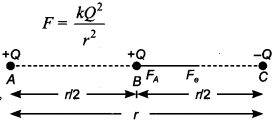
When a similar sphere B having charge +Q is kept at the mid-point of line joining A and C, then net force on B is
The direction is shown in figure.
6. A charge Q is divided into two parts of q and Q – q. If the coulomb repulsion between them when they are separated is to be maximum, the ratio of Q/q should be
(a) 2:1
(b) 1/2
(c) 4:1
(d) 1/4
Answer/Explanation
Answer: a
Explaination:
(a) Let separation between two parts be r, then
F = k.q(Q – q)/r² , For F to be maximum dF/dq = 0 then Q/q = 2/1 = 2 : 1
7. Four equal charges q are placed at the four comers A, B, C, D of a square of length a. The magnitude of the force on the charge at B will be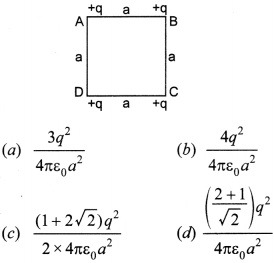
Answer/Explanation
Answer: c
Explaination: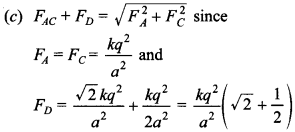
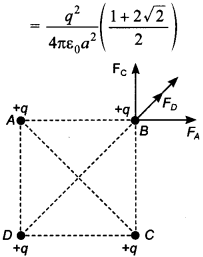
8. Dielectric constant for metal ______ .
Answer/Explanation
Answer:
Explaination:
Infinite [Dielectric constant K = \(\frac{\varepsilon}{\varepsilon_{0}}\)
Permittivity of metals (\(\E \)) is assumed to be very high.]
9. Two charges of equal magnitudes kept at a distance r exert a force F on each other. If the charges are halved and distance between them is doubled, then the new force acting on each charge is
Answer/Explanation
Answer: d
Explaination:
(d) F = \(\frac{k \cdot Q^{2}}{r^{2}}\). If Q is halved, r is doubled then F = \(\frac{1}{16}\) time
10. The electric field inside a spherical shell of uniform surface charge density is
(a) zero.
(b) constant, less than zero.
(c) directly proportional to the distance from the centre.
(d) none of the these
Answer/Explanation
Answer: a
Explaination:
(a) All charges reside on the outer surface of the shell so according to Gauss’s law, electric field inside the shell is zero.
11. A cylinder of radius R and length L is placed in a uniform electric field E parallel to the cylinder axis. The total flux for the surface of the cylinder is given by
Answer/Explanation
Answer: d
Explaination: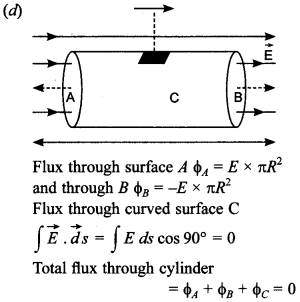
12. Electric field at a point varies as r° for
(a) an electric dipole
(b) a point charge
(c) a plane infinite sheet of charge
(d) a line charge of infinite length
Answer
Answer: c
13. An electric charge q is placed at the centre of a cube of side a. The electric flux on one of its faces will be
Answer/Explanation
Answer:
Explaination: (a) Using Gauss’s theorem
14. Total electric flux coming out of a unit positive charge kept in air is
Answer/Explanation
Answer: b
Explaination:
(b) Total flux coming out from the unit charge is![]()
15. The electric field intensity due to an infinite cylinder of radius R and having charge q per unit length at a distance rir r(r > R) from its axis is
(a) directly proportional to r².
(b) directly proportional to r3.
(c) inversely proportional to r.
(d) inversely proportional to r².
Answer/Explanation
Answer: c
Explaination: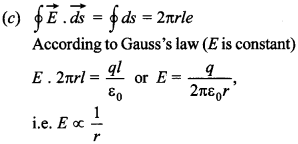
16. A point charge q is placed at a distance a/2 directly above the centre of a square of side a. The electric flux through the square is![]()
Answer/Explanation
Answer: d
Explaination:
(d) An imaginary cube can be made by considering charge q at the centre and given square is one of its face. So flux through the given square (i.e. one face)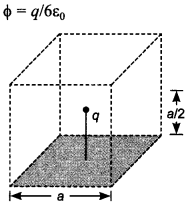
17. Which of the following graphs shows the variation of electric field E due to a hollow spherical conductor of radius R as a function of distance from the centre of the sphere?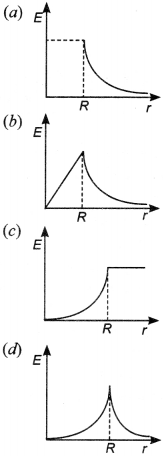
Answer/Explanation
Answer: a
Explaination:
(a) Electric field due to a hollow spherical conductor is governed by equations E = 0, for r < R …(i)
and \(E=Q / 4 \pi \varepsilon_{0} r^{2}\) for r ≥ R ….(ii)
i.e. inside the conductor, electric field will be zero and outside the conductor it will vary according to E oc 1/r².
18. The magnitude of electric field intensity E is such that, an electron placed in it would experience an electrical force equal to its weight is given by
(a) mge
(b) mg/e
(c) e/mg
(d) e²g/m²
Answer/Explanation
Answer: b
Explaination: (b) According to the question, eE = mg or E = mg/e
19. In Fig. (i) two positive charges q2 and q3 fixed along the y-axis, exert a net electric force in the +x direction on a charge q1 fixed along the x-axis. If a positive charge Q is added at (x, 0) in figure (ii), the force on q1 is [NCERT Exemplar]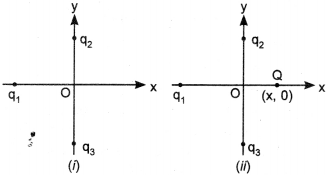
(a) shall increase along the positive x-axis.
(b) shall decrease along the positive x-axis.
(c) shall point along the negative x-axis.
(d) shall increase but the direction changes because of the intersection of Q with q2 and qy
Answer/Explanation
Answer: a
Explaination:
(a) The net electrostatic force on the charge q1 by the charges q2 and q3 is along the positive x-direction. Hence the nature of force between qu q2 and qx, q3 should be attractive. It means qx should be negative.
20. Which of the following statement is correct? The electric field at a point is [NCERT Exemplar]
(a) always continuous.
(b) continuous if there is a charge at that point.
(c) discontinuous only if there is a negative charge at that point.
(d) discontinuous if there is a charge at that point.
Answer/Explanation
Answer: d
Explaination:
(d) The electric field due to any charge will be continuous, if there is no other charge in the medium. It will be discontinuous if there is a charge at the point under consideration.
21. A point charge +q is placed at a distance d from an isolated conducting plane. The field at a point P on the other side of the plane is [NCERT Exemplar]
(a) directed perpendicular to the plane and away from the plane.
(b) directed perpendicular to the plane but towards the plane.
(c) directed radially away from the point charge.
(d) directed radially towards the point charge.
Answer/Explanation
Answer: a
Explaination:
(a) The electric field lines are away from positive charge and perpendicular to the surface. Hence the field at a point P on the other side of the plane is directed perpendicular to the plane and away from the plane.
22. Gauss’s law will be invalid if
(a) there is magnetic monopoles.
(b) the inverse square law is not exactly true.
(c) the velocity of light is not a universal constant.
(d) none of these.
Answer
Answer: b
23. SI unit of permittivity of free space is
(a) Farad
(b) Weber
(c) C2N-1 m-2
(d) C2N-1 m-2
Answer
Answer: c
24. A charge Q is placed at the centre of the line joining two point charges +q and +q as shown in the figure. The ratio of charges Q and q is![]()
(a) 4
(b) 1/4
(c) -4
(d) -1/4
Answer
Answer: d
25. The force per unit charge is known as
(a) electric flux
(b) electric field
(c) electric potential
(d) electric current
Answer
Answer: b
26. Electric field lines provide information about
(a) field strength
(b) direction
(c) nature of charge
(d) all of these
Answer
Answer: d
27. Which of the following figures represent the electric field lines due to a single negative charge?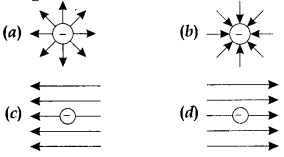
Answer
Answer: b
28. The SI unit of electric flux is
(a) N C-1 m-2
(b) N C m-2
(c) N C-2 m2
(d) N C-1 m2
Answer
Answer: d
29. The unit of electric dipole moment is
(a) newton
(b) coulomb
(c) farad
(d) debye
Answer
Answer: d
30. Consider a region inside which, there are various types of charges but the total charge is zero. At points outside the region
(a) the electric field is necessarily zero.
(b) the electric field is due to the dipole moment of the charge distribution only.
(c) the dominant electric field is inversely pro-portional to r3, for large r (distance from ori-gin).
(d) the work done to move a charged particle along a closed path, away from the region will not be zero.
Answer
Answer: c
31. The surface considered for Gauss’s law is called
(a) Closed surface
(b) Spherical surface
(c) Gaussian surface
(d) Plane surface
Answer
Answer: c
32. The total flux through the faces of the cube with side of length a if a charge q is placed at corner A of the cube is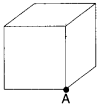

Answer
Answer: a
33. Which of the following statements is not true about Gauss’s law?
(a) Gauss’s law is true for any closed surface.
(b) The term q on the right side side of Gauss’s law includes the sum of all charges enclosed by the surface.
(c) Gauss’s law is not much useful in calculating electrostatic field when the system has some symmetry.
(d) Gauss’s law is based on the inverse square dependence on distance contained in the coulomb’s law
Answer
Answer: c
34. Four charges are arranged at the comers of a square ABCD, as shown. The force on the charge kept at the centre O is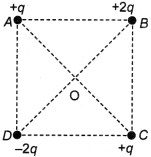
(a) zero
(b) along the diagonal AC
(c) along the diagonal BD
(d) perpendicular to side AB
Answer/Explanation
Answer: c
Explaination:
(c) Place a unit positive charge at O. Resultant force due to the charges placed at A and C is zero and resultant charge due to B and D is towards D along the diagonal BD.
35. One end of a copper wire is connected to a neutral pith ball and other end to a negatively charged plastic rod. What will be the charge acquired by a pith ball? [Chennai 2019]
Answer/Explanation
Answer:
Explaination: Negative charge.
36. Distinguish between an insulator (dielectric) and a conductor.
Answer/Explanation
Answer:
Explaination:
Dielectrics do not have free electrons, while conductors have free electrons. When some charge is transferred to a conductor, it readily gets distributed over the entire surface of the conductor, but on insulators, the charge stays at the same place.
37. Why does a nylon or plastic comb get electrified on combing or rubbing but a metal spoon does not?
Answer/Explanation
Answer:
Explaination:
The charge on a metal spoon discharges through our body to the ground as both are conductors. But when a nylon or plastic comb is rubbed, due to the friction its acquires a negative (-ve) charge, which stays on it as it is an insulator.
38. Two metallic spheres having same shape and size, but one of Cu and other of Al, are both placed in an identical electric field. In which metallic sphere will more charge be induced?
Answer/Explanation
Answer:
Explaination:
Same charge will be induced on both the spheres. As the dielectric constant K = oo for metals and the induced charge is given by q’ = \(=-q\left(1-\frac{1}{K}\right)\).
39. What causes the charging of an object?
Answer/Explanation
Answer:
Explaination:
When an object looses or gains electrons by friction/conduction/induction, then it is charged.
40. What does the additive nature of electric charge mean?
Answer/Explanation
Answer:
Explaination:
It means an electric charge is a scalar quantity and is added like algebraic numbers.
41. When does a charged ring behave as a point charge?
Answer/Explanation
Answer:
Explaination:
When the radius of ring is much smaller than the distance under consideration.
42. Two insulated charged copper spheres A and B of identical size have charges qA and qB respectively. A third sphere C of the same size but uncharged is brought in contact with the first and then in contact with the second and finally removed from both. What are the new charges on A and B1 [Chennai 2019, Foreign 2011]
Answer/Explanation
Answer:
Explaination:
43. What does q1 + q2 = 0 signify?
Answer/Explanation
Answer:
Explaination:
q1 + q2 = 0
⇒ q1 = – q2
∴ q1 and qq2 are the two charges of an electric dipole.
44. What is the cause of quantisation of electric charge?
Answer/Explanation
Answer:
Explaination:
The minimum charge that is stable, is charge of an electron. Since, electrons are transferred from one object to another, therefore, electric charge is said to be quantised.
45. What do you mean by conservative nature of the electric force?
Answer/Explanation
Answer:
Explaination:
The electric force is conservative in nature, because the work done by it in moving a charge is path independent.
46. If a body contains n1 electrons and n2 protons, then what will be the total amount of charge on the body?
Answer/Explanation
Answer:
Explaination:
Electric charge on n1 electrons = – n1e and electric charge on n2 protons = + n2e Therefore, the total charge = (n2 – n1)e.
47. What is the limitation of Coulomb’s law?
Answer/Explanation
Answer:
Explaination: It is applied only for point charges.
48. What does e(absolute permittivity) signify?
Answer/Explanation
Answer:
Explaination: It is a measure of the degree to which a medium can resist the movement of charges.
49. Define 1 coulomb (1 C) of electric charge.
Answer/Explanation
Answer:
Explaination:
One coulomb is that charge, when placed in vacuum at a distance of one metre from an equal and similar charge, would repel it with a force of 9 × 109 N.
50. Write two properties of an electrostatic force.
Answer/Explanation
Answer:
Explaination:
(a) It is conservative in nature.
(b) It depends on medium between the two charges.
51. Is the force acting between two point electric charges qx and q2 kept at some distance apart in air, attractive or repulsive when
(i) q1q2 > 0
(ii) q1q2 < 0?
Answer/Explanation
Answer:
Explaination:
(i) When q1q2 > 0, force is repulsive.
(ii) When q1q2 < 0, force is attractive.
52. The force on an electron kept in an electric field in a particular direction is F. What will be the magnitude and direction of the force experienced by a proton kept at the same point in the field? Mass of the proton is about 1836 times the mass of the electron.![]()
Answer/Explanation
Answer:
Explaination: Same in magnitude and opposite in the direction as F = e.E
53. How does the coulomb force between two point charges depend upon the dielectric constant of the intervening medium?
Answer/Explanation
Answer:
Explaination:![]()
Coulomb force is inversely proportional to the dielectric constant of the intervening medium.
54. State principle of superposition of forces.
Answer/Explanation
Answer:
Explaination:
Net force experienced by any charge in a group of charges is the vector sum of the forces acting on it due to rest of the charges of the group.
55. Define the dielectric constant of a medium. What is its unit? [Delhi 2011C]
Answer/Explanation
Answer:
Explaination:
Dielectric constant of a medium is defined as the ratio of the force between two charges placed a certain distance apart in vacuum to the force between the same two charges placed the same distance apart in the medium. It has no units.
56. Two equal balls having equal positive charge q coulombs are suspended by two insulating strings of equal length. What would be the effect on the force when a plastic sheet is inserted between the two? [AI 2014]
Answer/Explanation
Answer:
Explaination:
Electric force will reduce as plastic is an insulator. The force between the two charges will reduce by 1/K, where K is the dielectric constant of plastic.
57. Two electric field lines never cross each other. Why?
Answer/Explanation
Answer:
Explaination:
Two field lines can never cross each other. If they did, the field at the point of intersection will not have a unique direction, which is absurd.
58. Draw the electric field lines due to apoint charge
(i) Q > 0 and (ii) Q< 0.
Answer/Explanation
Answer:
Explaination:
(i) Q > 0 (ii) Q < 0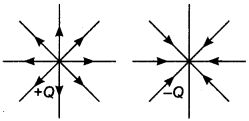
59. Why do the electric field lines not form any closed loops?
Answer/Explanation
Answer:
Explaination:
Because they originate from positive (+ve) charge and terminate at negative (-ve) charge.
60. Draw electric field lines for a system of two charges q1 and q2 such that
(i) q1q2 >0; q1>q2>0
(ii) q1 q2 <0; q1 > |-q2| < 0, |q1|> |-q2|
Answer/Explanation
Answer:
Explaination: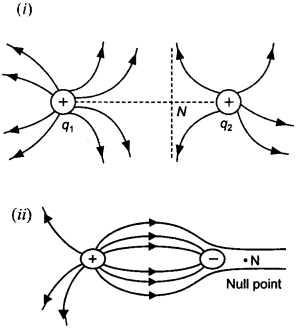
61. Draw the electric field lines if (i) a point charge + q is placed at the centre (ii) a point charge + q is placed at a distance R/2 from the centre.
Answer/Explanation
Answer:
Explaination:
62. What is the physical significance of electric field?
Answer/Explanation
Answer:
Explaination:
From the knowledge of electic field intensity at any point, we can readily calculate the magnitude and the direction of force experienced by any .charge q0 placed at that point.
63. Define the term electric dipole moment. Is it a scalar or a vector quantity?
Answer/Explanation
Answer:
Explaination:
The product of the magnitude of one of the point charges constituting an electric dipole and the separation between them is termed as electric dipole moment.
It is a vector quantity.
64. What is an ideal (point) dipole?
Answer/Explanation
Answer:
Explaination:
An ideal dipole is the dipole whose size (2a) is vanishingly small, and the magnitude of electric charges constituting by it is very large, and the product, i.e. 2aq is finite.
65. What is the value of \(\left|\frac{E_{a x}}{E_{e q}}\right|\) for a short electric dipole?
Answer/Explanation
Answer:
Explaination:
66. Two point charges +q and -q are placed at a distance d apart. What are the points at which the resultant electric field is parallel to the line joining the two charges?
Answer/Explanation
Answer:
Explaination:
(i) At any point on axial line.
(ii) At any point on equitorial line of a dipole.
67. If F is the magnitude of force experienced by a unit charge placed at a distance of 1 cm from an infinitely large charged sheet, then what will be the force experienced by the same charge placed at a distance of 2 cm from the same sheet? [HOTS]
Answer/Explanation
Answer:
Explaination:
In case of sheet of charge, the electric field is constant. Hence, F – qE will be same irrespective of distance.
68. What is the direction of net force on electric dipole, placed in a non-uniform electric field?
Answer/Explanation
Answer:
Explaination:
Since, the electric field at the location of charge -q is more than that of field at charge +q. Therefore, the direction of net force will be in the direction opposite to the direction of \(\vec{E}\).
69. When does an electric dipole placed in a non-uniform electric field experience a zero torque but non-zero force?
Answer/Explanation
Answer:
Explaination: When the dipole axis is parallel to the direction of electric field.
70. Name the physical quantity whose SI unit is V.m. Is it a vector or a scalar quantity?
Answer/Explanation
Answer:
Explaination: The physical quantity is an electric flux. It is a scalar quantity.
71. Define the term electric flux. Write its SI unit. [Foreign 2017]
Answer/Explanation
Answer:
Explaination:
Electric flux through an area is the product of magnitude of area and the component of electric field vector normal to it.![]()
72. What is a Gaussian surface?
Answer/Explanation
Answer:
Explaination:
A Gaussian surface is an imaginary closed surface in three dimensional space through with the flux of a vector field is calculated.
73. What is the use of a Gaussian surface?
Answer/Explanation
Answer:
Explaination:
A Gaussian surface is used to determine the electric field intensity around a point charge or charged body.
74. Why can a Gaussian surface not pass through any discrete charge?
Answer/Explanation
Answer:
Explaination:
Because the electric field due to a system of discrete charges is not defined at the location of any charge.
75. Two charges of magnitudes -2 Q and + Q are located at points (a, 0) and (4a, 0) respectively. What is the electric flux due to these charges through a sphere of radius 3a with its centre at the origin? [AI 2013]
Answer/Explanation
Answer:
Explaination:
According to the Gauss’s theorem, the total electric flux through any closed surface is equal to \(\frac{1}{\varepsilon_{0}}\) times, the total charge enclosed eo by the surface.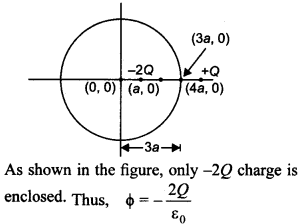
76. Does the charge given to a metallic sphere depend on whether it is hollow or solid? Give reason for your answer. [Delhi 2017]
Answer/Explanation
Answer:
Explaination: No. Electric charge resides on the outer surface only.
